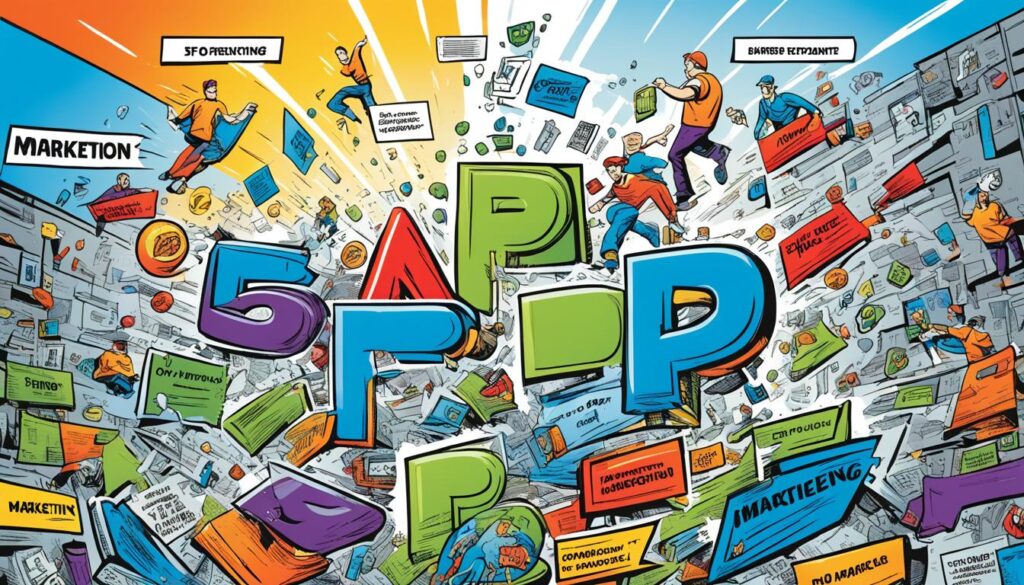Have you ever thought about the link between your needs and businesses that meet them? Every time you use your smartphone or go online, you’re in a huge marketplace. This is where brands try to connect, not just sell. In today’s fast world, with $16 billion spent on influencer marketing last year, knowing the 5 P’s of Marketing is key. These include Product, Price, Place, Promotion, and People. They help anyone starting or growing their business build a strong marketing plan.
As we dive into this guide, we’ll learn how to truly connect with potential buyers. Each of the 5 P’s works together to build better relationships with customers. This means you won’t just attract people; you’ll keep them coming back. Join us as we uncover how to effectively brand and succeed in marketing.
Key Takeaways
- The 5 P’s of Marketing consist of Product, Price, Place, Promotion, and People.
- Over $16 billion was spent on influencer marketing in 2022, showing how key brand relationships are.
- Understanding customer personas is crucial for tailor-made marketing strategies.
- Dynamic pricing, like Amazon’s approach, is changing how we buy things.
- How a product gets to customers is vital for its success.
- Ad campaigns and other promotional techniques are important for drawing in customers.
- Decisions about customer experience can make or break a brand’s reputation.
Introduction to the 5 P’s of Marketing
In today’s competitive market, knowing the 5 P’s of Marketing is crucial. These are product, place, price, promotion, and people. This way of thinking about marketing has been around since the 1940s. It now includes “people” to focus on customers.
The 5 P’s guide shows us how to present products or services. Warby Parker, for example, has a pricing strategy that attracts budget-minded shoppers. Companies like Hu focus on organic ingredients to appeal to those who value health.
The rise of digital technology means businesses must focus on what customers want. Gathering customer data is key to creating personalized experiences. This helps stand out and keep customers coming back. The balance of product, price, promotion, place, and people is vital for marketers today.
Mastering the 5 P’s lets you improve your marketing. This ensures you meet the needs of your customers well.
What Are the 5 P’s of Marketing?
The 5 P’s of Marketing include Product, Price, Place, Promotion, and People. This idea forms the core of a strong marketing strategy. Edmund Jerome McCarthy introduced it in the 1960s, focusing on four key areas. Later, due to tech growth and changing customer tastes, the People aspect was added. Now, we have the 5 P’s framework.
To build a great marketing plan, knowing each P is crucial. Product means what you sell, like goods or services that answer people’s needs. Then there’s Price. It’s all about setting the right cost. This factors in how much it takes to make your product and what similar items cost. Changing prices wisely can help attract more buyers, especially in new markets.
Place talks about where your products are available and how they get to buyers. It matters whether you sell online, in stores, or both. Promotion is about letting people know what you offer. This includes ads, sponsoring events, and online marketing. Getting your message to the right people makes promotions more successful and can save money.
The last P, People, is about building strong relationships. Happy customers and a united team can take your brand beyond just products. People now want excellent service as much as they want great products. This shows how important each part of the 5 P’s is to marketing today.

| Element | Description |
|---|---|
| Product | Items or services designed to satisfy customer needs. |
| Price | Strategic pricing based on various market factors. |
| Place | Distribution channels and geographic accessibility. |
| Promotion | Awareness tactics, including advertising and digital campaigns. |
| People | Focus on customer relationships and team dynamics. |
Understanding the Product Element
The product element within the marketing mix is very important. It shows what your business offers to meet customer needs. Knowing what you sell in detail is key to a great product strategy.
It’s not just about what the product does. The design, quality, and brand experience matter too. Knowing this helps your product stand out in a busy market.
Defining Your Core Offering
Your core offering is the heart of your product strategy. It’s what your product or service really is and meets your customers’ main needs. When defining your core offering, think about:
- Functionality: What key problem does your product solve?
- Quality: How does your product’s quality stack up against competitors?
- Design: Is your product visually appealing and easy to use?
- Branding: How does your product show off your brand identity?
Features and Benefits of Your Product
Understanding your product’s features and their benefits is essential. Each feature should offer a clear benefit to the customer. Writing a strong product description helps highlight these points.
Think about making a table that shows features and their benefits:
| Product Feature | Product Benefit |
|---|---|
| Durable materials | Long-lasting use, reduced need for replacements |
| User-friendly design | Easy to use, reduces learning curve |
| Customizable options | Meets individual customer needs and preferences |
| Eco-friendly packaging | Appeals to environmentally-conscious consumers |

Knowing your core offerings and product features boosts customer happiness. It leads to more sales and loyalty to your brand. Knowing how your products help your customers is key to refining your strategy and being successful for a long time.
Exploring Pricing Strategies
Understanding how to set prices right is key in the business world. It’s about linking price to how customers see value. Setting the right prices matches what buyers expect, keeps up with the market, and covers costs.
How Pricing Influences Perception
Prices shape how people think about what they’re buying. They may see a product’s price as a sign of its quality. Businesses must show why their product is worth it. Higher prices can suggest better quality.
Key strategies include:
- Creating tiered pricing models for different kinds of customers.
- Implementing bundling strategies to boost value.
- Using pricing psychology, like $9.99 prices instead of $10.
Prices can change how people view a product, helping brands stand out and keep customers coming back.
Pricing Models and Their Impact on Sales
Different pricing strategies can help increase sales and grow a business. Here are some popular ones to think about:
| Pricing Model | Description | Benefits |
|---|---|---|
| Cost-Plus Pricing | Adding a markup to the cost of goods sold. | Makes pricing easier; ensures a set profit. |
| Dynamic Pricing | Adjusting prices based on supply and demand changes. | Increases revenue by adapting to the market. |
| Subscription Pricing | Charging for ongoing access to a product or service. | Ensures steady income and keeps customers returning. |
| Freemium Pricing | Free basic services with charges for premium features. | Attracts lots of users to later become buyers. |
These models address different needs. They focus on how consumers see value, affecting sales.

Place: The Distribution Channel
It’s essential to know the distribution channels to reach your audience effectively. A good distribution strategy meets customers’ needs and makes logistics better. It’s important to choose the right sales channels, like online platforms or physical stores. This choice can greatly affect how you enter the market. Each has its own benefits, and it’s vital to match them with what the market wants for success.
Identifying the Best Distribution Channels
Choosing the best sales channels requires looking at many factors. These include what customers like and the competitive scene. When figuring out their distribution strategy, businesses should:
- Assess customer convenience and accessibility
- Evaluate the cost-effectiveness of different channels
- Understand market competition
- Consider the reach of each sales channel
Geographic Rollout Strategies
A smart geographic market rollout can lead to growth. This means adjusting your plans to fit local tastes. A successful rollout can quickly grab market share. Brands like Starbucks pick locations that get a lot of people and are easy to see. This helps them meet customer needs well.
Stores aim for the best shelf spots, while digital sites like YouTube or Netflix make it easy to access their content globally.

Adapting to local markets while having a solid distribution plan boosts your marketing. By understanding logistics and distribution, you can increase sales and make customers happier.
| Distribution Channel | Advantages | Challenges |
|---|---|---|
| Physical Retail Stores | Direct customer interaction, brand experience | Higher overhead costs, limited geographic reach |
| Online Platforms | Wider audience, lower operating costs | Higher competition, reliance on digital marketing |
| Direct Sales | Personalized service, deeper customer relationships | Resource-intensive, requires skilled sales personnel |
Promotion: Creating Brand Awareness
Promotion is key in the marketing world, especially for getting the word out about your brand. It uses smart promotion methods and different ads to show what’s great about your product and connect with people.
Key Promotion Channels
To spread the word about your brand far and wide, it’s important to use a mix of promotion channels. Here are some usual methods:
- Traditional Advertising: TV, radio, and newspapers still get to lots of people, making them good for wide-reaching ads.
- Digital Marketing: Using social media, getting your website to show up in searches, and ads that you pay for per click helps reach specific groups and track how well your ads do.
- Public Relations: Making connections with the media can get your brand talked about positively and often.
- Influencer Collaborations: Teaming up with influencers makes your brand seem more real and spreads the word to their followers.
Integrated Marketing Communications
For your brand to really stick in people’s minds, it’s crucial to make sure your message is the same everywhere. Integrated Marketing Communications (IMC) ties all your strategies together, making your brand’s message clear and strong at every touchpoint. This doesn’t just help people remember your brand; it also gets them more involved with what you’re offering.
When you’re planning your promotion, think about telling a story. Brands like Nike are pros at making people feel something strong. This emotional connection makes customers more loyal and aware of the brand.

| Promotion Channel | Description | Benefits |
|---|---|---|
| Traditional Advertising | Mass media advertising to reach a broad audience. | Higher visibility and brand recognition. |
| Digital Marketing | Online strategies including social media and SEO. | Targeted reach and measurable impact. |
| Public Relations | Management of public perceptions through media. | Improved brand credibility and exposure. |
| Influencer Collaborations | Partnerships with social influencers to promote products. | Increased authenticity and access to new audiences. |
The Role of People in Marketing Success
In marketing, the “People” factor is key to winning customers and keeping them happy. Getting to know your clients and crafting messages that speak to them is important. This focus on the human side helps build lasting bonds with customers.
Understanding Customer Personas
Knowing your customers well starts with figuring out your customer personas. These profiles come from looking closely at market research. They include things like who your customers are and what they care about. With this knowledge, you can create marketing that really hits the mark.
Doing interviews, surveys, and using tools to gather data helps build these personas. This lets you see what your customers truly need and want. It’s a smart move to make sure your marketing messages hit home.
Building Relationships and Retaining Customers
At the heart of good marketing is creating strong connections with your customers. When you make their experiences personal and care about their feedback, trust grows. Remember, real, meaningful relationships are the backbone of lasting loyalty.
Companies focused on their customers tend to do better than those who don’t. They enjoy more loyalty and people speaking well of them. This approach leads to customers sticking around longer and supporting the brand.

| Strategy | Description | Impact on Customer Relationships |
|---|---|---|
| Feedback Loops | Regularly collecting and analyzing customer feedback. | Enhances satisfaction and loyalty by addressing concerns. |
| Personalization | Customizing services and messages based on persona data. | Increases relevance and emotional connection with customers. |
| Community Engagement | Building online and offline communities around your brand. | Fosters belonging and increases brand loyalty. |
| Customer Support | Providing responsive and helpful service via various channels. | Strengthens trust and demonstrates commitment to customer success. |
Using these strategies makes your marketing efforts strike a chord with your audience. It proves that understanding your customers and valuing them leads to success. These efforts tie together the crucial aspects of personas and relationships.
How to Apply the 5 P’s of Marketing Effectively
To use the 5 P’s of Marketing well, you need a smart plan. It should include Product, Price, Promotion, Place, and People. When these are lined up right, your marketing can really hit its mark. Checking out success stories helps businesses see how to do it.
Aligning All Elements for Success
Good marketing comes from blending all the key parts just right. Each one needs to work with the others to be strong. Here’s what to keep in mind:
- Product: Make sure your product fits what people want and expect.
- Price: Set competitive prices that show your product’s worth and get people buying.
- Promotion: Use different ways to get your brand known, like blogs and teaming up with influencers.
- Place: Place your products where your customers can easily find them.
- People: Work on building a good team and understanding your customers to create strong bonds.
Real-world Examples of Successful Application
Looking at how Canva and Tesla did it shows the 5 P’s in action. Canva attracts users with its easy-to-use design tools, good prices, and smart marketing. Tesla changed the car world with great products, right pricing, and bold marketing moves.

Keep checking how you do with these elements to stay on top of the market. It’s vital to tweak your tactics based on what customers say and what’s happening in the market. This helps keep the 5 P’s working together well.
| Company | Key Element | Strategy | Outcome |
|---|---|---|---|
| Canva | Product | User-friendly features | High user engagement |
| Tesla | Price | Competitive pricing strategies | Market disruption |
| Ahold Delhaize | Place | New “click-and-collect” locations | 68.9% increase in online sales |
| Hubspot | Promotion | Content funnel strategy | Enhanced customer engagement |
Using these examples can guide businesses to work the 5 P’s into their strategy. This leads to steady growth and happy customers.
Importance of the 5 P’s of Marketing – 5 P’s of Marketing
The 5 P’s are key in marketing. They help pinpoint your core values and guide your marketing. Knowing each one well makes your efforts stronger. This way, you see the big picture for your business.

Let’s break down the 5 P’s: Product, Price, Place, Promotion, and People. Take Microsoft, for example. They match their products to what people need. Their easy-to-use system stands out, winning over many users.
Price matters too. If prices are too low, they might push customers away. Having a range of prices makes buyers see the value. This can make them stick with you.
Where you sell is crucial. The right spots mean your products find their people. Good promotion then helps you get seen and trusted. This draws in loyal customers.
People emphasizes a happy workplace. Happy teams provide great service and match your brand’s values. Firms that grasp how these elements work together often do well in marketing.
Here’s a quick review of the 5 P’s and why they’re important:
| 5 P’s | Importance |
|---|---|
| Product | Meets market demand and defines core offerings |
| Price | Influences customer perception and selection |
| Place | Determines how effectively products reach customers |
| Promotion | Enhances visibility and credibility |
| People | Strengthens customer relations and brand loyalty |
Using the 5 P’s can really shape up your digital marketing. This builds a solid base for lasting success and happy customers. It sets your brand apart when competing.
Conclusion
The 5 P’s of Marketing—Product, Price, Promotion, Place, and People—are fundamental for effective marketing strategies. Understanding these parts lets you make a plan that speaks to your audience. They help ensure your product is easy to get, priced right, and promoted well.
Strategic pricing is key for happy customers and good profits. While promotion matters, it’s crucial not to forget the other four P’s. Use customer referrals in your promotions. Keep your public relations consistent to boost brand loyalty and trust.
For marketing success, always look at your strategies and change them based on what customers say. By mixing the 5 P’s well, you connect with your customers. This leads to lasting success and a strong position in a competitive market.









